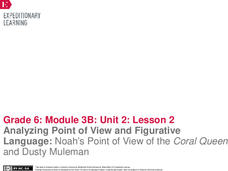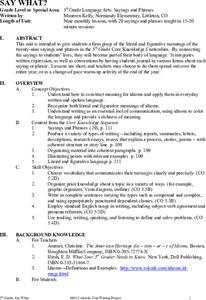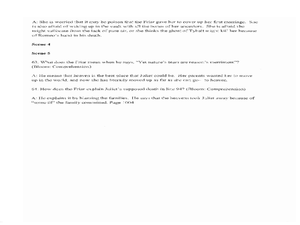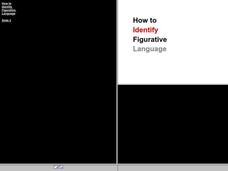Prestwick House
Discovering Genre: Poetry
Work on literal and figurative meanings with a lesson focused on Robert Frost's "After Apple-Picking" and "The Road Not Taken." Readers identify the literary devices used by the poet to set the poems' themes, settings, and narrative...
K12 Reader
Proverbs and Adages Match
The grass may be greener on the other side, but a instructional activity about proverbs and adages is sure to help readers of all levels master figurative language. Kids match the idioms in the first column to their literal meanings in...
EngageNY
Analyzing Point of View and Figurative Language: Noah’s Point of View of the Coral Queen and Dusty Muleman
Literally, what's the meaning? Scholars read pages seven through nine of Flush and discuss literal and nonliteral meaning with figurative language. Learners work in triads to identify and define unfamiliar words. They then complete a...
E Reading Worksheets
Idioms Test
How well do your class members understand the figurative meaning of idioms? Find out with this 15 question multiple choice assessment.
Curated OER
Metaphors in Context
Do your class members know where the phrase "raining cats and dogs" come from? They will after viewing a presentation about metaphors. The concise definitions and clear examples make for a strong introduction to this element of...
Curated OER
It's Raining Cats and Dogs
Make a beeline to this activity. Prepare paper strips with the provided idioms to engage teams in illustrating their literal meanings. The drawings provide the impetus for a guessing game where class members compete to be the first to...
Curated OER
Reading Examples
Young writers read excerpts from Gary Paulsen's memoir to identify figurative and literal language that contain sensory details. They determine which selections are examples of sensory language and fi the language is used literally or...
Curated OER
Idiom
In this idioms worksheet, students write meanings of the idioms provided to them. Students complete 20 idiom meanings on this worksheet.
Texas Education Agency (TEA)
Simile and Metaphor (English III Reading)
The key idea in this interactive exercise designed for high schoolers is that figurative language, especially similes, and metaphors, add layers of meaning to a text. Users examine examples from speeches, ads, movie dialogue, and poems,...
Wordoful.com
List of Idioms and Phrases
Good idioms are a dime a dozen. A 19-page list is only a drop in the bucket when it comes to figurative language and idiomatic phrases. So don't get a chip on your shoulder and dive in; learning what idioms really mean is a piece of cake!
Curated OER
It's Raining Cats and Dog: Studying Idioms
Seventh graders determine the literal and figurative meanings of idioms and research the history of idioms. In this idioms instructional activity, 7th graders read two books by Fred Gwynne and select two idioms from the texts to...
Curated OER
In a Pickle
Fifth graders listen to a story that uses homonyms and figurative language throughout the text. They illustrate the literal and figurative meanings of some figures of speech.
Curated OER
Say What?
Students explore the literal and figurative meanings of twenty-nine phrases and sayings. This unit of nine lessons integrates written expression and convention to demonstrate the value of idioms to the language.
Curated OER
Understanding Idioms Is a Piece of Cake
Interpreting idioms is a piece of cake! In groups, learners discuss the meaning of some common English idioms and choose 10 to use in sentences. Then, they illustrate the silly, literal meanings of those idioms and can engage in a fun...
Curated OER
Boys Will Be Boys...Right?
Through this exercise, high schoolers identify character traits present in Romeo and Juliet. They listen to an excerpt from "The Office of Christian Parents: Showing How Children Are to be Governed" and participate in a Socratic...
Curated OER
How To Identify Figurative Language
Students investigate writing techniques by analyzing a chart. In this figurative language lesson, students define similes, metaphors and identify the difference between them and personification. Students demonstrate their understanding...
Curated OER
Idioms...not the be taken literally!
Young scholars define common English idioms which they find in books and book excerpts. They use an idiom dictionary and constuct a database of five idioms along with meanings and sentences. They beam this information to classmates.
Curated OER
Eating Up Idioms
Ah, food idioms! Now that sounds tasty. Class members read and discuss various food-related idioms, create an illustration of a food-related idiom, and develop a class book or bulletin board to celebrate figurative language and National...
Curated OER
Figuring Out Frost
Fourth graders read "The Runaway" by Robert Frost and analyze it for its literal and symbolic meanings. They compare their personal experiences with the poet's suggestions about youthful attitudes and behaviors. Some nice worksheets are...
Shmoop
ELA.CCSS.ELA-Literacy.L.11-12.5
"Timid, scared, terrified." High school scholars examine words, their denotations and connotations, in a series of exercises that use lines from Shakespeare to explore figurative language and word relationships. Participants then...
Curated OER
Understanding Idioms
Learners explore figurative language. In this idioms lesson, students research the origin of instructor-selected idioms. Learners literally interpret the idioms. Interpretations are photographed and then presented to the class.
Curated OER
Similes
A simile is a non literal phrase that needs to be deciphered for contextual meaning. Similes are also fun to read and write. Third graders get cozy with similes found in the book If You Hopped Like a Frog by David M. Schwartz. They use...
Curated OER
Headless Horseman, Heady Author
Twelfth graders explore figurative language as it appears in Washington Irving's original text, The Legend of Sleepy Hollow, answer questions based on story, and write sequels to it by using the different types of figurative language...
Curated OER
Literary Techniques
Need to review literary terms/techniques with your class? The slides in this presentation define and give examples of 22 common literary terms. The PowerPoint could be used for AP test prep.

























